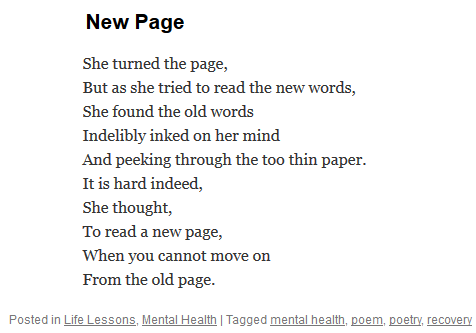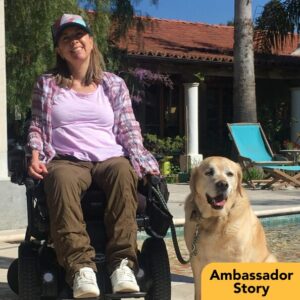Art can be a career, a therapeutic exercise, a stress reliever, a way to connect with loved ones or a healthy dose of ‘me-time’ in the midst of a hectic schedule.
In this post, artists identify the health benefits of creativity and explain how you can get involved in art, starting today.

HelpHOPELive client Gail Foster is a professional painter who is fighting spinal cord damage. In this article, Foster explains how art can be used to explore and express intense emotions during a time of medical difficulty.
Foster is joined by Dr. Pooky Knightsmith, a freelance mental health advocate, guest speaker and poet, who delivers her insights on the connection between creative expression and personal wellbeing.

Artists Gail Foster and Pooky Knightsmith.
What are the mental and physical benefits of art?
Foster: Studies have shown that art and music can decrease anxiety, improve emotional balance and even heal your immune system. Art can be a way to commemorate milestones or celebrate your recovery journey.
Knightsmith: Sometimes poetry can be used to express things which are too difficult to say out loud. The act of taking difficult thoughts and feelings and turning them into a poem can feel quite cathartic and can allow us to move on from the things that hold us down.

‘Golden Wing’ by Gail Foster.
What if I am too busy to fit art into my schedule?
Knightsmith: Art doesn’t have to be something that takes up a lot of time. I write a poem every day: it usually takes about ten minutes…it can be very beneficial just to have a few minutes each day which are truly your own. Many people find they enjoy those few minutes and can readily find them when they begin to look.
Foster: There are always distractions in our day-to-day lives: “I have dishes to do, I can’t do art right now…I have to finish running errands, I don’t have time to paint.” My best art happens when I make time for it, no matter how small a window of time I’m working with. Give me just ten minutes of that in an afternoon and, wow, that is a great day!

The poem New Page by Pooky Knightsmith.
What are your tips for getting started?
Foster: Whether you are starting out for the first time or getting back into art after an injury or illness, one way to get motivated is to get a group of friends together. Getting together as a group, regardless of the location, can be a motivating factor, even if your chosen mediums are different! Hobby painters, screenwriters, poets, novelists, fine artists…it’s exciting to be together and focus on a common interest.

‘Wish In Flight’ by Gail Foster
Can art help with healing after an injury or illness?
Knightsmith: While it depends on the individual, many people find that writing, in its many forms, can help them to explore difficult thoughts and feelings that surround their injury or illness. It can help simply to put our thoughts to paper – sometimes the act of writing, whether it’s a list or a play or a story or a poem, can help us to crystallize our thoughts.
Any time I’m unsure about something, I explore it in writing. There are also lots of difficult thoughts and feelings that go hand-in-hand with being a caregiver. Some are positive, some are negative and some are simply tiring. Being able to explore these feelings in words or with art can be hugely therapeutic.
Not all artistic endeavors need to be about exploring difficulties! Sometimes, art can simply be about celebrating positive moments in your life.

The poem Recovery Shines by Pooky Knightsmith.
What if I’m not creative or artistic?
Foster: From time to time, everyone asks themselves, ‘Can I do this?’ or ‘Is this possible?’ This inner dialogue occurs over and over and over. It’s really important to find a way to remind yourself (maybe physically) to put those negative or stress-filled voices away. About 17 years ago, I put a blue piece of tape down on the threshold of my art studio. Every time I cross the blue tape, I remind myself to leave my concerns and insecurities at the door. Put yourself there! That’s all it takes! Don’t let your internal dialogue (or thoughts about your potential or lack of potential) drive the process. Be open to everything.

Find a way to remind yourself to let go of your worries before you begin creating art, says Foster.
Knightsmith: If you feel like you don’t have what it takes to create, I’d recommend starting with adult coloring. You end up creating something really beautiful in the end without needing to have an artistic bone in your body.
HelpHOPELive: Our client Kathe Neely is a lifelong doodler and the publisher of a coloring book for adults. She adds, “I think coloring is a fantastic way to test and explore your interest in a creative outlet. It can be budget-friendly and is wonderfully mobile. I think that the ability to start with a design that is not overwhelming and allows to you see a result fairly quickly can be very satisfying and fulfilling. You would probably find that coloring that first tester page, whether it brings out further interest or not, was a nice mental break — even if it involved just a small portion of your day. That is an immeasurable “benefit of creativity.” ”

Sample images from Kathe Neely’s adult coloring book.
Do I have to share my art with other people?
Knightsmith: Sharing your work is a personal choice that depends on what you’ve created and why. Sometimes we create things just for ourselves to help us explore and manage. Sharing art and poetry can also feel like a very intimate thing and can, for that reason, be a great way to develop trusting, caring relationships.
Foster: Whether or not you plan to share your work, put your heart in it, and do it for yourself, not for anyone else. You can give your art away as gifts, share it with the public, share it with just a close circle or keep it for your eyes only. It’s up to you.

Keep your work to yourself, or share it with others. The choice is yours.
If art has impacted your life, share your story with us on Facebook or on Twitter!











